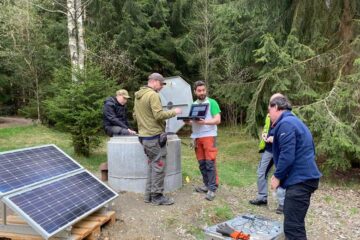The immune system of vultures: candidate for the European EURYI prize

The researcher at the Institute for Agrobiotechnology Natural Resources, José Manuel Pérez de la Lastra, has been chosen by the Consejo Superior de Investigaciones Científicas (CSIC) as candidate for the European EURYI prize, with total funding of between 750,000 and 1,250,000 euros over five years for young investigators.
José Manuel Pérez de la Lastra has been, since 2001, Ramón & Cajal research fellow at Institute of Agrobiotechnology, a mixed centre linking the CSIC and the Public University of Navarre.
EURYI (the European Programme of Contracts for Young Investigators) is an initiative of EUROHORC, the organisation that brings together the main research bodies of the European Union, by which 25 promising young investigators of any nationality are empowered to create their own research team in Europe and in any area of knowledge. To this end, they will each receive between 150,000 y 250,000 euros annually.
José Manuel Pérez de la Lastra has been chosen by the Consejo Superior de Investigaciones Científicas (CSIC), together with 34 other candidates who will have to pass another test at the Ministry of Education, Culture and Sport, and from which 13 candidates from Spain will be chosen to proceed to the European-wide Call.
Pioneering Research
The principal criteria for selection for the EURYI Programme are the scientific quality, the originality of and the potential for the investigation. The award recipients must promote innovative research, deal with related scientific problems and show novel methodologies. Moreover, candidates must have excellent c.v.’s and research records, having potential to become world leaders in their respective fields of investigation.
The project presented by Pérez de la Lastra involves the study of the “Molecular bases of the innate immune system of vultures”, a pioneer investigation in which this chemist from Cordoba (Spain) is currently working on. According to the author, it involves understanding how the vulture, which feeds on carrion, withstands pathogens.
Apart from the interest in knowing more about the organic functioning of this protected species – thus the study is being carried out with genetic data banks and not with vultures -, this research may have applications of great interest to human medicine. Thus, if it is shown that the receptors in the vultures are better than those of humans, their use can be patented in order to create biosensor and new molecules.
Media Contact
Alle Nachrichten aus der Kategorie: Förderungen Preise
Neueste Beiträge

Erstmals 6G-Mobilfunk in Alpen getestet
Forschende der Universität Stuttgart erzielen leistungsstärkste Verbindung. Notrufe selbst in entlegenen Gegenden absetzen und dabei hohe Datenmengen in Echtzeit übertragen? Das soll möglich werden mit der sechsten Mobilfunkgeneration – kurz…

Neues Sensornetzwerk registriert ungewöhnliches Schwarmbeben im Vogtland
Das soeben fertig installierte Überwachungsnetz aus seismischen Sensoren in Bohrlöchern zeichnete Tausende Erdbebensignale auf – ein einzigartiger Datensatz zur Erforschung der Ursache von Schwarmbeben. Seit dem 20. März registriert ein…

Bestandsmanagement optimieren
Crateflow ermöglicht präzise KI-basierte Nachfrageprognosen. Eine zentrale Herausforderung für Unternehmen liegt darin, Über- und Unterbestände zu kontrollieren und Lieferketten störungsresistent zu gestalten. Dabei helfen Nachfrage-Prognosen, die Faktoren wie Lagerbestände, Bestellmengen,…





















